| Authors: | Danny E.P. Vanpoucke |
| Ph.D. Thesis | at University of Twente, The Netherlands |
| date: | September 11th, 2009 |
| Promoters | Prof. Dr. Paul J. Kelly and Dr. Geert H. L. A. Brocks |
| doi: | 10.3990/1.9789036528733 |
| ISBN: | 978-90-365-2873-3 |
| #pages | 193 |
| export: | bibtex |
| pdf: | <PhD.Thesis> <UTwente> |
| research page with more information |
Abstract
The aim of this thesis: “Ab Initio Study of Pt Induced Nanowires on Ge(001)”, is to model the experimentally observed ‘Pt nanowires’ on Ge(001). These one-atom-thick wires can be hundreds of nanometers long while remaining defect and kink free, providing the ultimate wire any chip designer dreams of. However, experiments show the wires not to be conducting; on the contrary, one-dimensional states are discovered between the wires. To model these nanowires, we combine state of the art density functional calculations with calculated scanning tunneling microscope (STM) images. First, the β-terrace substrate is modeled, showing a checkerboard pattern of Pt-Ge and Ge-Ge surface dimers in a Ge(001)-reconstructed surface.
Starting from this substrate model, different models with increasing Pt density are developed in an iterative fashion showing increasing agreement with the experimentally observed nanowires. We show that, contrary to previous assumptions, the observed wires are not Pt atoms but Ge atoms, explaining the lacking conductivity. The germanium nanowires consist of Ge dimers located in a Pt-lined trough. In addition, the 4×1 periodicity observed in the nanowire-arrays is traced back to the bonds of the Ge nanowire dimers to an extra Pt atom at the bottom of the trough, resulting in the buckling of the nanowires dimers.
In the last part of the thesis we investigate the adsorption of CO on the Ge nanowires under study. The observed adsorption of CO seems to contradict our proposed model due to the high sticking probability of CO on Pt, where it is low on Ge. We show that no contradiction exists. The CO molecules bind to the Pt atoms in the surface, but because they are tilted toward the nanowires, the resulting STM images give the impression that they are located on top of the nanowire giving rise to the apparent contradiction. In this last study, we also discover a very stable CO adsorption configuration in which the CO molecules remain invisible for STM, but could allow for the formation of one-dimensional molecular chains. This would open the door to one-dimensional molecular electronics.


